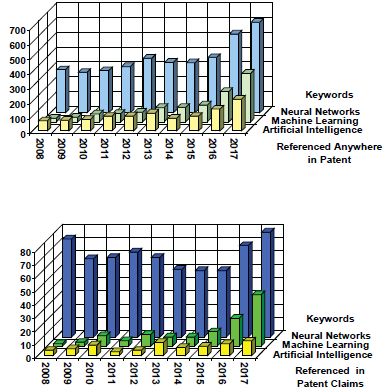A recent EPO report1 talks about "A new era of technological development characterised by digital transformation", based on "information and communication technologies" ("ICT") and amounting to a "fourth industrial revolution". The present review looks at three specific aspects of ICT – neural networks, machine learning and artificial intelligence – which the EPO report groups together as "enabling machine understanding".
Developments of these aspects may relate to their implementing hardware and software or to any of the extensive range of their possible applications, for example from assisting medical diagnosis to image recognition to natural language understanding to operating wind turbines to playing the game of go. This means that capture of relevant patents and applications using the International Patent Classification (IPC) is challenging, as incidentally illustrated by the EPO report.
This review takes a simple and direct approach: using full texts2 and keywords "neural network", "machine learning" and "artificial intelligence"3, searches for European patents having patent (B1) publication dates over the 10-year period 2008 to 2017 were carried out.
5052 patents published (B1) in that 10-year period reference at least one keyword, 750 with references in claims.

The chart below gives counts by year of patents referencing any of the keywords anywhere in titles, abstracts, descriptions or claims, and counts of those with references in claims. The counts increased significantly in 2016/2017.

The increase should be seen in the context of the overall increase in total grants (patents published) since 2015.

The top ten IPC subclasses of the keyword patents include A61B (Diagnosis; Surgery; Identification), C12Q (Measuring or Testing Processes involving Enzymes, Nucleic Acids or Microorganisms), A61K (Preparations for Medical, Dental, or Toilet Purposes) and C12N (Microorganisms or Enzymes; Compositions thereof), showing the growing importance of bioinformatics.
| Rank | IPC Subclass | No. of Patents | Rank | IPC Subclass | No. of Patents |
| 1 | G06F | 688 | 6 | G06T | 321 |
| 2 | G01N | 589 | 7 | C12Q | 317 |
| 3 | A61B | 473 | 8 | A61K | 287 |
| 4 | G06K | 375 | 9 | G05B | 279 |
| 5 | H04L | 354 | 10 | C12N | 264 |
Top patentees for patents referencing the keywords are listed in the table below.
| Patentee | Keyword Patents Publd (B1) 2008-2017 | Keyword(s) in Patents claims |
| Qualcomm | 121 | 3 |
| Siemens | 119 | 47 |
| Philips | 111 | 12 |
| Microsoft | 102 | 23 |
| Honda | 66 | 14 |
| Samsung | 64 | 7 |
| Sony | 54 | 8 |
| Roche | 51 | 2 |
| GE | 50 | 6 |
| Ericsson | 46 | 0 |
| Rockwell Automation | 43 | 13 |
| Robert Bosch | 40 | 4 |
| ABB | 39 | 12 |
| Celera Corp | 34 | 0 |
| Fraunhofer Ges | 33 | 3 |
| Alcatel Lucent | 32 | 6 |
| BASF Enzymes | 32 | 0 |
| Nokia | 32 | 7 |
| Canon | 30 | 5 |
| Xerox | 29 | 3 |
| 27 | 1 | |
| Deutsche Telekom | 26 | 0 |
| Novozymes | 25 | 0 |
| LG | 22 | 2 |
| Panasonic | 22 | 7 |
| Huawei | 21 | 2 |
| BP | 20 | 1 |
| Honeywell | 20 | 6 |
| Astute Medical | 19 | 0 |
| Fisher Rosemount | 19 | 1 |
| Verenium Corp | 19 | 0 |
| British Telecomms | 18 | 1 |
| Fujifilm | 18 | 3 |
| Nestec | 18 | 3 |
| IBM | 17 | 5 |
| Telecom Italia | 17 | 3 |
| Volkswagen | 17 | 3 |
| Avaya | 16 | 0 |
| Fujitsu | 16 | 1 |
| Harman Becker Auto | 16 | 4 |
| Agensys | 15 | 0 |
| Blackberry | 15 | 1 |
| Boeing | 15 | 3 |
| Commissariat A L Energie Atomique ETC | 15 | 3 |
| Medimmune | 14 | 0 |
| United Technologies | 14 | 1 |

The charts on the right give counts by year of patents referencing each of the keywords anywhere in titles, abstracts, descriptions or claims, and counts of those with references in claims.
As also seen above, the levels of patents referencing the keywords in claims are a fraction (ca. 15%) of the levels of patents referencing the keywords anywhere in titles, abstracts, descriptions or claims. Overall, of patents referencing the keywords in claims only around 30% reference the keywords in claim 1.
This might suggest that inventions involved are less often focused on developments to "neural network", "machine learning" or "artificial intelligence" devices or processes as such, but rather more often concerned with developments which may incidentally or optionally involve such devices or processes as component parts or steps in something aimed at achieving some further "technical" goal (e.g. operating wind turbines or image recognition). This may reflect an expectation that claiming developments to "neural network", "machine learning" or "artificial intelligence" devices or processes per se could challenge the limits of what the EPO regards as "technical" (as opposed to unpatentably "non-technical", e.g. "as such" programs for computers or mathematical methods). However, an improved AI system per se, if functioning as operational layer software which improves the way a computer itself operates, may well be seen as technical by the EPO. Otherwise, directing claims to a further "technical" goal employing the "neural network", "machine learning" or "artificial intelligence" might be expected to mitigate problems at the EPO.
In any event, the trend for patents linked to machine understanding through the keywords "neural network", "machine learning" and "artificial intelligence" has recently been upwards, though the levels of patents concerned are as yet very small fractions still of total European patents.
Footnotes
1. "Patents and the Fourth Industrial Revolution: the inventions behind digital transformation" December 2017 http://www.epo.org/service-support/publications.html?pubid=163#tab3
2. As available on the EPO's online EP full text search database (https://data.epo.org/expert-services/index-2-3-8.html )
3. The exact terms or near, in English, French and German
The content of this article is intended to provide a general guide to the subject matter. Specialist advice should be sought about your specific circumstances.



